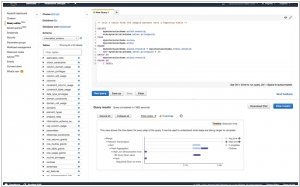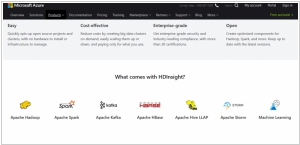Amazon Redshift vs Azure HDInsight
June 03, 2023 | Author: Michael Stromann
12

Amazon Redshift is a fast, fully managed, petabyte-scale data warehouse service that makes it simple and cost-effective to efficiently analyze all your data using your existing business intelligence tools. You can start small for just $0.25 per hour with no commitments or upfront costs and scale to a petabyte or more for $1,000 per terabyte per year, less than a tenth of most other data warehousing solutions.
Amazon Redshift and Azure HDInsight are both cloud-based big data analytics platforms, but they have different underlying technologies and features.
Amazon Redshift is a fully managed data warehousing service provided by Amazon Web Services (AWS). It is designed to handle large-scale data sets and perform complex analytics queries. Redshift is built on a columnar storage architecture and uses massively parallel processing (MPP) to distribute data and processing across multiple nodes. It offers high scalability, fast query performance, and is optimized for data warehousing and business intelligence workloads. Redshift integrates well with other AWS services and supports various data integration and transformation capabilities.
Azure HDInsight, on the other hand, is a cloud-based big data platform offered by Microsoft Azure. It is based on the Apache Hadoop ecosystem and provides managed clusters for processing big data workloads. HDInsight supports a wide range of open-source frameworks such as Hadoop, Spark, Hive, HBase, and more. It enables users to store, process, and analyze large volumes of data using distributed computing frameworks. HDInsight is flexible and allows users to choose the specific frameworks and tools they want to use for their analytics workflows.
See also: Top 10 Big Data platforms
Amazon Redshift is a fully managed data warehousing service provided by Amazon Web Services (AWS). It is designed to handle large-scale data sets and perform complex analytics queries. Redshift is built on a columnar storage architecture and uses massively parallel processing (MPP) to distribute data and processing across multiple nodes. It offers high scalability, fast query performance, and is optimized for data warehousing and business intelligence workloads. Redshift integrates well with other AWS services and supports various data integration and transformation capabilities.
Azure HDInsight, on the other hand, is a cloud-based big data platform offered by Microsoft Azure. It is based on the Apache Hadoop ecosystem and provides managed clusters for processing big data workloads. HDInsight supports a wide range of open-source frameworks such as Hadoop, Spark, Hive, HBase, and more. It enables users to store, process, and analyze large volumes of data using distributed computing frameworks. HDInsight is flexible and allows users to choose the specific frameworks and tools they want to use for their analytics workflows.
See also: Top 10 Big Data platforms



